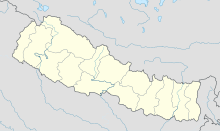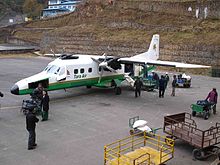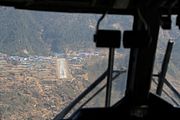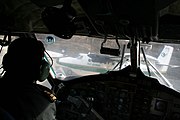4:23 AM Unknown
Tenzing–Hillary Airport
Tenzing–Hillary Airport (
IATA:
LUA,
ICAO:
VNLK), also known as
Lukla Airport, is a small
airport in the town of
Lukla,
[2] in
Khumbu,
Solukhumbu District,
Province No. 1, eastern
Nepal. A program titled
Most Extreme Airports, broadcast on
The History Channel in 2010, rated the airport as the most dangerous airport in the world for over 20 years.
[3]
In January 2008 the airport was renamed in honor of
Sherpa Tenzing Norgay and
Sir Edmund Hillary, the first people to reach the summit of
Mount Everest and also to mark their efforts in the construction of this airport.
[4]
The airport is popular because Lukla is the place where most people start the climb to
Mount Everest Base Camp. There are daily flights between Lukla and
Kathmandu
during daylight hours in good weather. Although the flying distance is
short, rain commonly occurs in Lukla while the sun is shining brightly
in Kathmandu. High winds, cloud cover, and changing visibility often
mean flights can be delayed or the airport closed. The airport is
contained within a chain link fence and patrolled by the
Nepali armed police or
civil police around the clock.
[3]
Facilities
Landing and taking off at Tenzing–Hillary Airport.
The airport's paved
asphalt runway is accessible only to
helicopters and small, fixed-wing,
short-takeoff-and-landing aircraft such as the
De Havilland Canada DHC-6 Twin Otter,
Dornier Do 228,
L-410 Turbolet and
Pilatus PC-6 Turbo Porter. The runway is 527 m (1,729 ft) × 30 m (98 ft) with a 11.7%
gradient.
[1] The airport's elevation is 9,334 ft (2,845 m).
[1]
The airport is not only used for passenger flights, but also for
transporting most of the building material and cargo to the town, as
most of the roofs on the houses at Lukla have to be transported by
aircraft.
Arriving and departing aircraft must use a single
runway. There is low prospect of a successful
go-around on
short final
due to the terrain. There is high terrain immediately beyond the
northern end of the runway and a steeply angled drop at the southern end
of the runway into the valley below.
Airlines and destinations
Accidents and incidents
- On 15 October 1973, a Royal Nepal Airlines DHC-6 Twin Otter 300 (registration 9N-ABG) was damaged beyond repair on landing. The three crew and three passengers were unhurt.[8]
- On 9 June 1991, a Royal Nepal Airlines DHC-6 Twin Otter 300 (registration 9N-ABA) from Kathmandu crashed at the airport while attempting to land following an unstabilized approach in bad weather. The three crew and fourteen passengers escaped with injuries.[9]
- On 26 September 1992, a Royal Air Nepal Harbin Yunshuji Y-12-II (registered 9N-ACI) faltered during takeoff and was damaged beyond repair. All twelve passengers and two crew survived.[10]
- On 25 May 2004, while on approach to the airport, a Yeti Airlines DHC-6 Twin Otter 300
(registration 9N-AFD) from Kathmandu crashed into Lamjura Hill in heavy
clouds. No passengers were on board; all three crew members were
killed. The Nepalese accident investigation committee concluded that the
captain provided inaccurate information about his position to the Area
Control Centre.[11]
- On 1 October 2004, on landing at the airport, a Sita Air Dornier Do 228
suffered a collapse of its nose gear and slid along the runway,
blocking it once it had come to rest. The airport was closed for two
days.[12]
- On 30 June 2005, a Gorkha Airlines Dornier Do 228
skidded off the runway while attempting to land. The nine passengers
and three crew suffered minor injuries. The aircraft was reportedly
withdrawn from service and written off after the accident.[13][14]
- On 8 October 2008, Yeti Airlines Flight 103, a DHC-6 Twin Otter 300
(registration 9N-AFE) crashed on final approach and caught fire,
killing eighteen passengers and crew. The aircraft's captain was the
only survivor. Video of the incident showed inclement weather at the
time of the incident.[15]
- On 12 October 2010, a Sita Air Dornier Do 228
(registration 9N-AHB) lost braking control and struck the wall-end of
the runway during landing. All passengers and crew escaped injury; the
aircraft's nose was damaged.[16]
- On 26 September 2013, an Air Dynasty helicopter
(registration 9N-AEX) crashed when the rear rotor touched the barbed
wire of the compound wall at the airport. All three passengers and the
captain survived.[17]
- On May 27th 2017, Summit Air Flight 409 was performing a freight flight on a Let L-410
from Kathmandu to Lukla (Nepal) with three crew, was on final approach
to Lukla's runway 06 at about 14:04L (08:19Z) with poor visibility when
the aircraft contacted a tree short of the runway and subsequently
contacted ground about 3 meters/10 feet below the runway level. The
aircraft slid down the slope before coming to a rest about 200 meters
below the runway level. The captain was killed and the first officer
died in hospital almost eight hours later. The third crew member
received injuries and was evacuated to Kathmandu the following day after
the weather had cleared.[18][19][20]
Gallery
A panoramic photograph of Lukla Airport and its surroundings.
|
|
|
Twin Otter approaching the airport
|
|
|
|
Twin Otters on the airfield
|
|
|
|
The runway in 1999 before paving
|
|
See also
References










0 comments:
Post a Comment